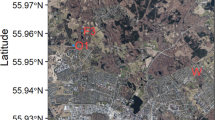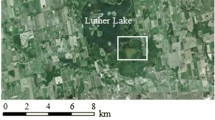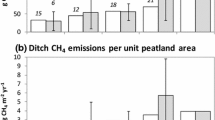Abstract
Methane and carbon dioxide fluxes were quantified for 14 ditches and larger water bodies in Dutch peatlands, surrounded by different habitat types, using concentration changes in floating flux chambers. Average fluxes from these waters were 11 ± 2 (mean ± SE) mg CH4 m−2 h−1 (n = 66) and 86 ± 21 mg CO2 m−2 h−1 (n = 55). Variability among water bodies was substantial in both gases and could be explained by water depth and surrounding habitat. Ditches in intensively used dairy land or rough pastures had significantly higher CH4 emission rates (17 ± 6 and 18 ± 8 mg CH4 m−2 h−1) than those in reed and sedge beds or open water (7 ± 1 and 5 ± 2 mg CH4 m−2 h−1). Bubbles contributed between 34 and 69% to the total CH4 flux, with higher proportions observed in ditches sheltered by tall vegetation. Observed day-time CO2 fluxes were either positive (shaded ditches in reed and sedge stands or rough pasture; 120–150 mg CO2 m−2 h−1) or did not differ from zero (open water, ditches in intensively managed pasture). Since these peatlands have substantial areas of permanent surface water (6–43%), landscape-scale carbon flux estimates are improved by incorporating specific flux estimates for these waters.

Similar content being viewed by others
References
Aerts R (2000) Possibilities for carbon storage in grasslands on peat in the Netherlands. In: Van Amstel A (ed) Monitoring CO2 sinks in the Netherlands: priorities for improvement. Wageningen University, Wageningen, pp 25–27
Bakker SA, Jasperse C, Verhoeven JTA (1997) Accumulation rates of organic matter associated with different successional stages from open water to carr forest in former turbaries. Plant Ecol 129:113–120
Best EPH, Jacobs FHH (1997) The influence of raised water table levels on carbon dioxide and methane production in ditch-dissected peat grasslands in the Netherlands. Ecol Eng 8:129–144
Dias ATC, Hoorens B, Van Logtestijn RSP, Vermaat JE, Aerts R (2010) Plant species composition can be used as a proxy to predict methane emissions in peatlands after land-use changes. Ecosystems 13:526–538
Franken ROG, Van Vierssen W, Lubberding HJ (1992) Emissions of some greenhouse gases from aquatic and semi-aquatic ecosystems in the Netherlands and opitons to control them. Sci Tot Env 126:277–293
Hendriks DMD, Van Huissteden J, Dolman AJ, Van der Molen MK (2007) The full greenhouse gas balance of an abandoned peat meadow. Biogeosciences 4:411–424
Kechavarzi C, Dawson Q, Leeds-Harrison PB, Szatyłowicz J, Gnatowski T (2007) Water-table management in lowland UK peat soils and its potential impact on CO2 emission. Soil Use Manage 23:359–367
Kersting K, Kouwenhoven P (1989) Annual and diel oxygen regime in two polder ditches. Hydrobiol Bull 23:111–123
Langeveld CA, Segers R, Dirks BOM, Van den Pol-Dasselaar A, Velthof GL, Hensen A (1997) Emissions of CO2, CH4 and N2O from pasture on drained peat soils in the Netherlands. Eur J Agron 7:35–42
Le Mer J, Roger P (2001) Production, oxidation, emission and consumption of methane by soils: a review. Eur J Soil Biol 37:25–50
Nol L, Verburg PH, Heuvelink GBM, Molenaar K (2008) Effect of land cover on nitrous oxide inventory in fen meadows. J Environ Qual 37:1209–1219
Nykänen H, Alm J, Silvola J, Tolonen K, Martikainen P (1998) Methane fluxes on boreal peatlands of different fertility and the effect of long-term experimental lowering of the water table on flux rates. Glob Biogeochem Cycles 12:53–69
Olde Venterink H, Vermaat JE, Pronk M, Wiegman F, Van der Lee GEM, Van den Hoorn MW, Higler LWG, Verhoeven JTA (2006) Importance of sedimentation and denitrification for plant productivity and nutrient retention in various floodplain wetlands. Appl Veg Sci 9:163–174
Saarnio S, Winiwarter W, Leitao J (2009) Methane release from wetlands and watercourses in Europe. Atmos Environ 43:1421–1429
Salm JO, Kimmel K, Uri V, Mander U (2009) Global warming potential of drained and undrained peatlands in Estonia: a synthesis. Wetlands 29:1081–1092
Schothorst CJ (1977) Subsidence of low moor peat soils in the western Netherlands. Geoderma 17:265–291
Schrier-Uijl A, Kroon PS, Leffelaar PA, Van Huissteden JC, Berendse F, Van Veenendaal EM (2010a) Methane emissions in two drained peat agro-ecosystems with high and low agricultural intensity. Plant Soil 329:509–520
Schrier-Uijl A, Kroon PS, Hensen A, Leffelaar PA, Berendse F, Van Veenendaal EM (2010b) Comparison of chamber and eddy covariance-based CO2 and CH4 emission estimates in a heterogeneous grass ecosystem on peat. Agric For Meteorol 150:825–831
Schrier-Uijl A, Veraart AJ, Leffelaar PA, Berendse F, Van Veenendaal EM (2011) Release of CO2 and CH4 from lakes and drainage ditches in temperate wetlands. Biogeochemistry 102:265–279
Van den Pol-Van Dasselaar A, Oenema O (1999) Methane production and carbon mineralisation of size and density fractions of peat soils. Soil Biol Biochem 31:877–886
Van den Pol-Van Dasselaar A, Van Beusichem ML, Oenema O (1999) Methane emissions from wet grasslands on peat soil in a nature preserve. Biogeochemistry 44:205–220
Van Oene H, Burgerhart N, Berendse F (2001) Inundation of reclaimed fen areas reduces greenhouse gas emissions and creates new nature reserves. Change 59:12–14
Van Strien AJ, Van der Burg T, Rip WJ, Strucker RCW (1991) Effects of mechanical ditch management on the vegetation of ditch banks in Dutch peat areas. J Appl Ecol 28:501–513
Veenendaal EM, Kolle O, Leffelaar PA, Schrier-Uijl AP, Van Huissteden J, Van Walsem J, Moller F, Berendse F (2007) CO2 exchange and carbon balance in two grassland sites on eutrophic drained peat soils. Biogeosciences Discussions 4:1633–1671
Verhoeven JTA (1992) Fens and bogs in The Netherlands, vegetation, history, nutrient dynamics and conservation. Kluwer, Dordrecht. Geobotany 18
Vermaat JE, Hellmann F (2010) Covariance in water- and nutrient budgets of Dutch peat polders: what governs nutrient retention? Biogeochemistry 99:109–126
Walter KM, Smith LC, Chapin FS III (2007) Methane bubbling from northern lakes: present and future contributions to the global methane budget. Philosophical Transactions of the Royal Society A 365:1657–1676
Walter KM, Chanton JP, Chapin III FS, Schuur EAG, Zimov SA (2008) Methane production and bubble emissions from arctic lakes: isotopic implications for source pathways and ages. Journal of Geophysical Research 113:G00A089
Whalen SC (2005) Biogeochemistry of methane exchange between natural wetlands and the atmosphere. Environ Eng Sci 22:73–94
Wheeler BD, Proctor MCF (2000) Ecological gradients, subdivisions and terminology of north-west European mires. J Ecol 88:187–203
Whiting GJ, Chanton JP (2001) Greenhouse carbon balance of wetlands: CH4 emission versus carbon sequestration. Tellus Ser B 53:521–528
Wilson JO, Crill PM, Bartlett KB, Sebacher DI, Harriss RC, Sass RL (1989) Seasonal variation of methane emissions from a temperate swamp. Biogeochemistry 8:55–71
Wilson D, Alm J, Laine J, Byrne KA, Farrell EP, Tuittila E-S (2008) Rewetting of cutaway peatlands: are we re-creating hot spots of methane emissions? Restor Ecol 7:796–806
Acknowledgments
Our work was funded by the ‘Climate changes spatial planning’ programme as BSIK-KvR ME5. Part of the field work was conducted by Joanna Gorska and Cristina Garcia Perez. The technical workshop staff of the Faculty of Earth and Life Sciences made our practical and durable chambers. We thank Elmar Veenendaal, Arina Schrier-Uijl, Dimmy Hendriks and Ko van Huissteden for cooperative discussion.
Author information
Authors and Affiliations
Corresponding author
Rights and permissions
About this article
Cite this article
Vermaat, J.E., Hellmann, F., Dias, A.T.C. et al. Greenhouse Gas Fluxes from Dutch Peatland Water Bodies: Importance of the Surrounding Landscape. Wetlands 31, 493–498 (2011). https://doi.org/10.1007/s13157-011-0170-y
Received:
Accepted:
Published:
Issue Date:
DOI: https://doi.org/10.1007/s13157-011-0170-y




